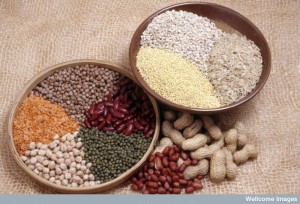W0030903 Cereals and legumes
Credit: Wellcome Library, London. Wellcome Images
images@wellcome.ac.uk
http://wellcomeimages.org
This image shows various types of cereals and legumes. These are the two most important plant food groups.
Cereals are the seeds of plants belonging to the grass family. Rice, wheat and corn are the major staple foods, followed by rye, barley, millet and oats. The grains are high in carbohydrate and protein, and contain vitamins and minerals in their outer layer.
Legumes (chickpeas, peas, beans, peanuts, lentils) are also high in carbohydrate and protein, and in the case of soya beans and peanuts, high in oil. Dried legumes have a low water content and a high carbohydrate and protein content. They are good sources of micronutrients, usually containing significant amounts of thiamin, niacin, riboflavin, phosphorus, non-haem iron and calcium. In vegetarian communities, legumes are important in improving iron intake.
Legumes (except for peanuts) are an important complement to cereal staples in all parts of the world. They add interest to meals and increase palatability. Legumes also increase the nutritional value of the meal by providing amino acids which are deficient in the cereal staple. This complementary combination of foods is capable of providing the individual’s complete protein requirements.
Mid 20th century Published: –
Copyrighted work available under Creative Commons by-nc-nd 4.0, see http://wellcomeimages.org/indexplus/page/Prices.html
